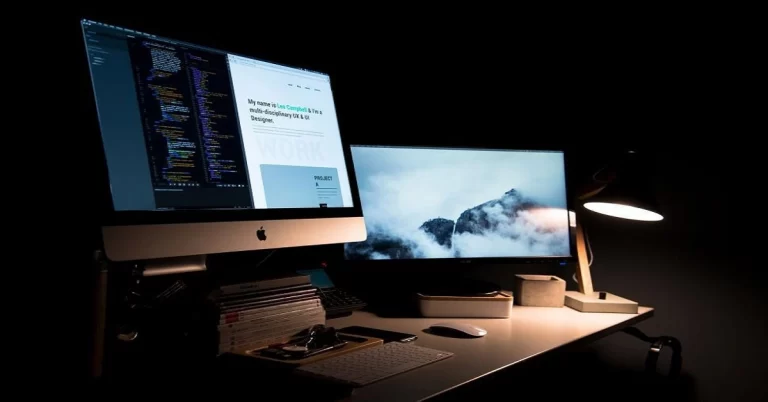As opposed to laptops, desktops are designed for stationary use in one location and offer greater customization and upgrade potential as your needs shift.
However, desktops require numerous components that make them cumbersome and costly to move around. If portability is key for you, a laptop would likely be the better choice.
What is a Desktop Computer?
A desktop computer consists of a monitor, keyboard and mouse connected via USB ports or cables to its central processing unit (CPU). It typically resides on a desk surrounded by other peripheral hardware like printers; desktops can also be interconnected through networks for enterprise computing as well as used individually for gaming and other activities at home.
Early desktop PCs used cathode ray tube (CRT) displays, while modern machines use liquid crystal display (LCD), light emitting diode (LED), or organic LED displays (OLED). Monitors typically sit atop computer cases; however some all-in-one desktops (AIOs) combine both screen and processor into one unit that sits flat on desks.
Desktops are not portable computers; they require an uninterruptible power source with long-lasting electricity to ensure its stable and uninterrupted use. While desktops provide more stability and functionality than laptops, their lack of portability limits their value and makes carrying between locations cumbersome.
Types of Desktop Computers
There are various kinds of desktop computers, including tower and all-in-one PCs (AIO). Tower PCs typically consist of a case that holds all components within, including motherboard, processor and hard drive; monitor, keyboard and mouse are included as standard features. AIO PCs feature all components built directly into their monitor screen reducing clutter for a sleek design.
Tower and AIO PCs can be configured with various hardware components depending on your specific needs, for maximum performance without compromising storage capacity. Some can even come fitted with both solid state drives and traditional hard disk drives to maximize speed without reducing capacity.
Desktop computers can be used for running an array of software and programs, from word processing to video editing. Their larger displays make them suitable for tasks requiring multiple windows or complex design applications, and you can upgrade your experience by installing high-performance graphics cards or more powerful CPUs that meet the demands of more demanding software and games.
Processors
Computer processors are at the core of every computer system. Their task is to interpret binary signals sent from programs, your operating system and other hardware components to execute instructions, perform calculations and make decisions logically and calculate probabilities quickly and reliably. They transfer data between memory banks quickly while their tiny yet powerful transistor-equipped chips provide fast input/output processing at high rates.
There are various types of processors on the market today, from budget-friendly models that are suitable for everyday tasks to high-performance ones designed specifically to address more intensive workloads like video editing and 3D gaming. When selecting a CPU for your desktop PC, make sure it fits with its intended use – budget friendly or performance based should do.
Intel and AMD are two main processor manufacturers offering an assortment of different processors with various performance levels and pricing models. When selecting a processor, key factors to keep in mind include its core count, clock speed, cache size and architecture – in particular multicore CPUs which offer increased performance for tasks such as data processing. They can also handle more complex math and logic operations faster than their single core counterparts.
Memory
As your computer performs tasks, information moves back and forth between RAM and long-term storage, with an ideal process moving at maximum speed. Unfortunately, if your system lacks adequate RAM resources it could spend too much time moving data between RAM and disk than actually accomplishing its tasks, resulting in what is known as “thrashing.”
Imagine your computer hard drive or SSD as filing cabinet and RAM as your desk: your programs work best when everything they require is at their fingertips; thus the more RAM you have available will improve PC performance.
Computer memory comes in the form of rectangular flat circuit boards with rows of memory chips attached, commonly referred to as DIMMs (Dual In-Line Memory Module). They come with capacities up to 16GB; older computers use SDRAM while newer ones utilize DDR (double data rate). Each memory chip transmits data by rising and falling with system clock speed; the faster this occurs, the faster your computer can transfer information into and out of RAM.
Hard Drives
Hard drives are the foundation of modern computing technology and serve as the primary storage device on desktop and laptop computers. These nonvolatile magnetic disk devices use magnetic field storage technology to hold digital information that changes over time, providing access to constantly updating digital information. There are two primary types of hard drives: internal and external.
HDDs contain multiple rotating platters that store data, along with a read/write head that scans them to retrieve information. An actuator arm of this head generates small magnetic fields to manipulate domains on each platter that represent digital information stored on it.
When the CPU needs access to a file, it issues an order to the HDD to read its contents. The read speed depends on how far apart its platters and actuator arm are; this distance may affect boot-up times.
HDDs typically come in two physical sizes: 2.5 inches for laptops and freestanding storage devices and 3.5 inches, which are more often found in desktop computers. Their size depends on its capacity, measured in gigabytes – so larger hard drives generally offer greater capacities.


